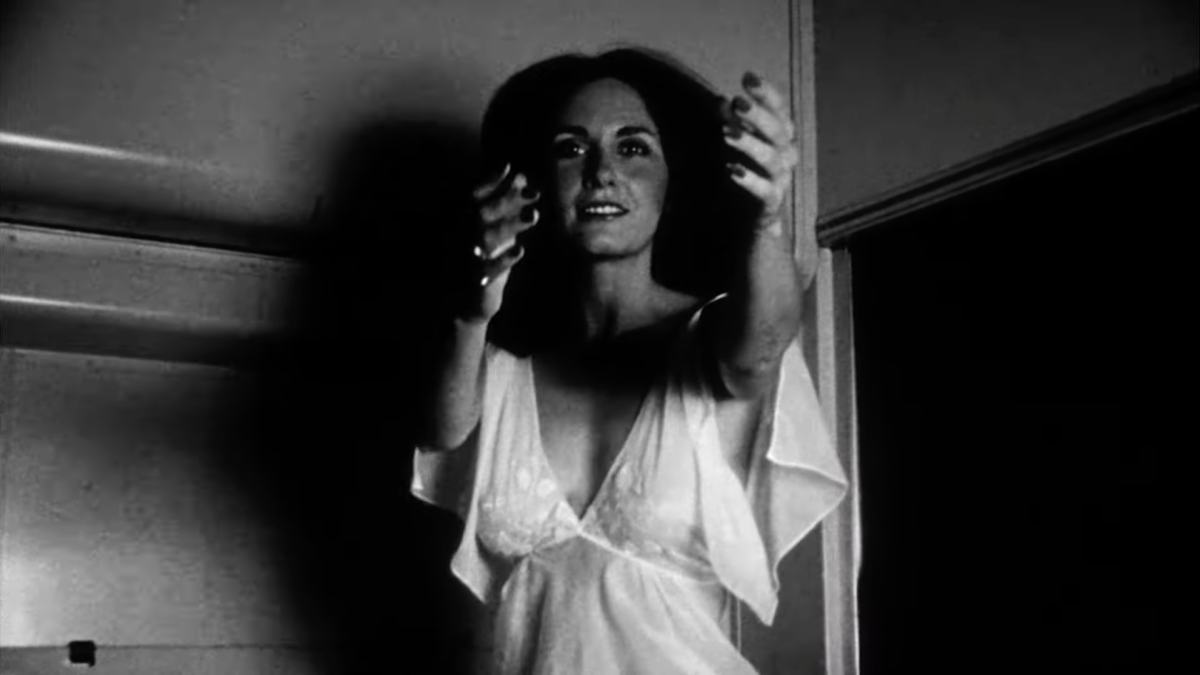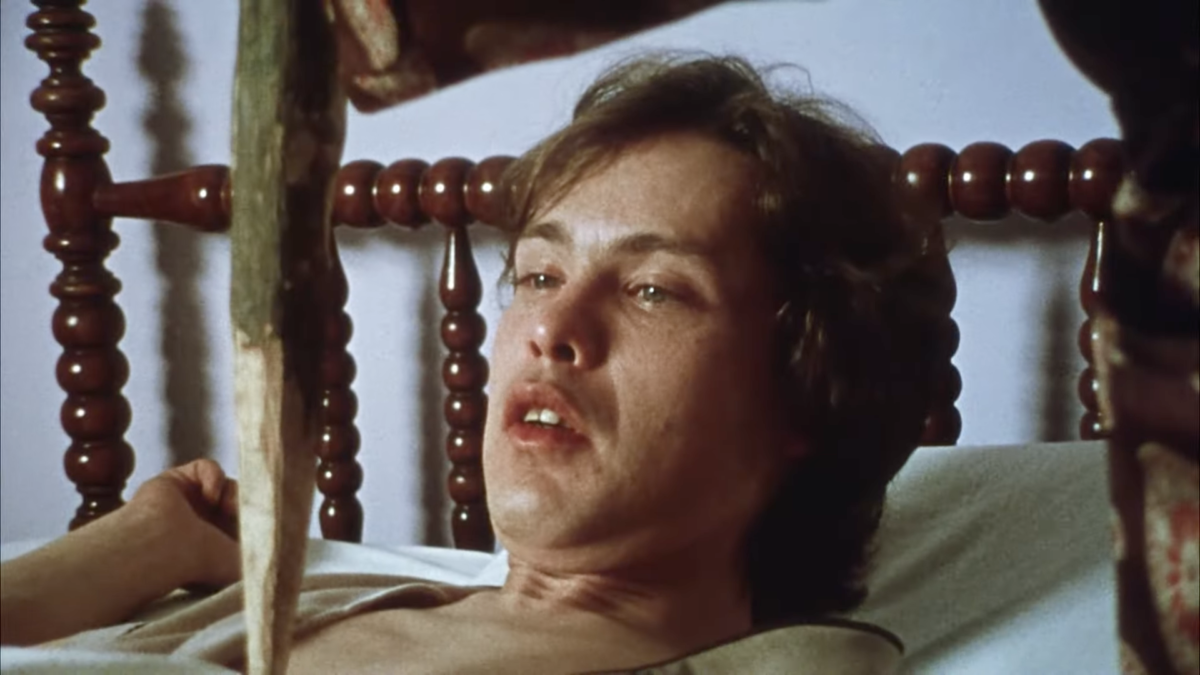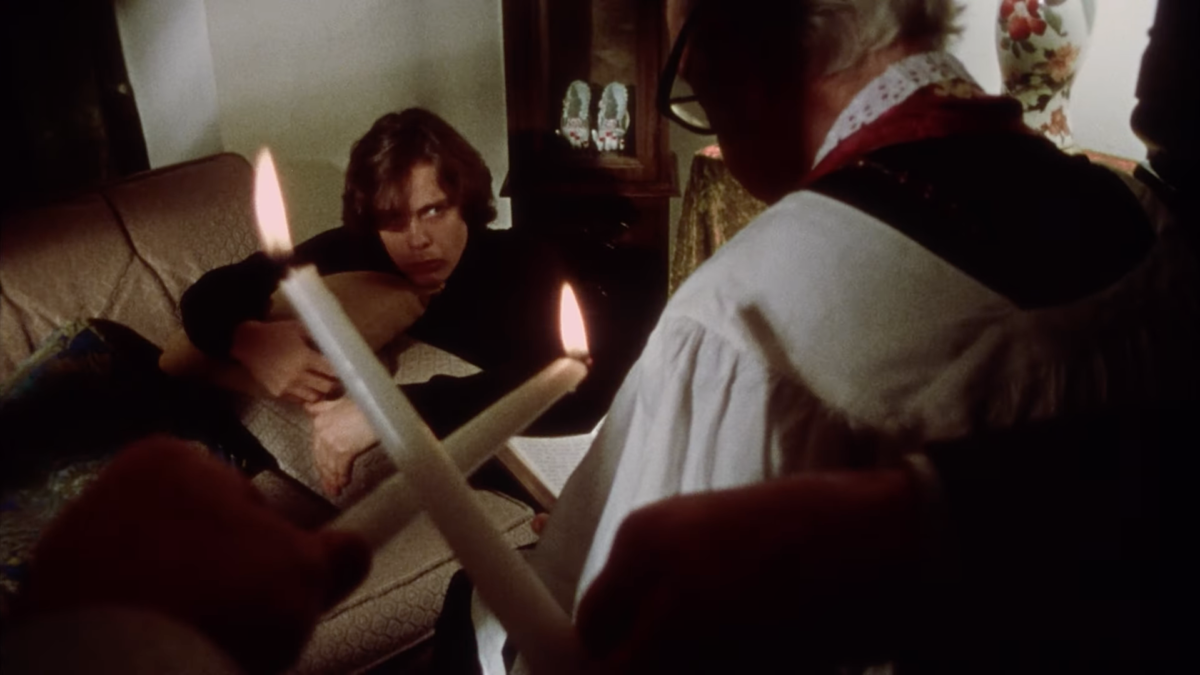In the brief seconds of black that open George A. Romero’s 1977 film Martin, a voice shouts out from the darkness. It’s not the screams of one of the eponymous pseudo-vampire’s victims or the bellows of an angry mob, fiery torches held aloft—though there are plenty of those to come. Instead, it’s the sound of a train guard barking a command: “All aboard!” It’s fitting that the film begins with an open entreaty to cross a threshold, given how concerned it is with the man-made mythology surrounding vampires, and the crippling compromises inherent to such a hunger-stricken existence. It’s also one of a very scant few times our viewpoint will drift from the film’s focal point, Martin.
Existing simultaneously as an 84-year-old vampire from the old world and an emotionally troubled 19-year-old down-and-out in 1970s America, Martin (John Amplas) is introduced mid-hunt. As he steps past the camera onto the train, Romero cuts to an outside perspective of Martin, establishing our connection with this strange figure; poe-faced and long-haired, yet youthful in spite of his gauntness. But Martin’s attention is elsewhere, staring with an insidious intensity at a young woman boarding the same train, a candid cut to his perspective of her hair twirling confirming her ignorance of his peeping. With these two close-ups, Romero not only makes the viewer complicit in Martin’s voyeurism, but further forces them to acknowledge the pressures of Martin’s hunger; for blood on the surface, and for intimacy beneath that. And that’s the compromise inherent to Martin’s existence as a social outcast—whether or not he feeds, he struggles regardless; our compromise as an audience is empathising with him in spite of his monstrosity.
Ever since Nosferatu (Murnau, 1922) ushered in the first era of horror, vampires have held an enviable position amongst ghouls and monsters alike. Though they most often reside in cobweb-clad cliff-side castles, surrounded by visible decay and with limited amenities, their position at the mountain top still speaks to a degree of privilege, particularly over the village folk who speak in hushed voices in the tavern below. Unlike the beast-like fur of the werewolf or the dehumanising bindings covering a mummy, vampires are suave in a recognisably human manner, dressed in dramatic cloaks or fine suits. Perhaps that’s why the vampire hasn’t only elicited empathy in viewers, but intimate attraction. Far before Robert Pattinson sparkled his way into the hearts of teenagers the globe over in Twilight (Hardwicke, 2008), Christopher Lee’s leering rendition of Dracula in the Hammer horror of the same name (Fisher, 1958) drew attention for the thrall he held over the women on screen and the audience at home. As Lee himself remarked, “It’s a mysterious matter and has something to do with the physical appeal of the person who’s draining your life. It’s like being a sexual blood donor…”Leonard Wolf (1977): A Dream of Dracula
Martin, perhaps the first postmodern vampire film, frames the vampire as a tragic figure worthy of compassion, asking viewers to confront the ethical basis of that tempered tenderness. On one level, Martin is a reprehensible monster, preying on the vulnerable in a manner that’s as calculated as it is upsettingly violent—drugging them before slashing their wrists to suck their blood. And on the other, he’s the prototypical lonely outsider, brow-beaten by his cousin-turned-abusive ward Tateh Cuda (Lincoln Maazel), and on-the-run from a traumatic past, desperate for some form of human connection. We recognise that for Martin every waking moment involves a concession on one of these two fronts, pitched between a carnal hunger and a longing for acceptance. The fact that his contradictory impulses mirror our own swaying allegiances speaks deeply to director/writer/editor George A. Romero’s command of his craft.
By shooting on location in Braddock, Pittsburgh in fuzzy 16mm, Romero immediately defuses the vampiric mystique surrounding Martin, favouring an aesthetic closer to contemporary cinéma vérité than the studio backlots and kitschy plywood sets used in Universal’s classic monster movies; more Jeffrey Dahmer than Bela Lugosi. Working with first-time cinematographer Michael Gornick (a Pittsburgh native, which shows in his eye for the scene-setting) Romero frames Martin against the rusty husks of Pittsburgh’s failed steel industry, trading the grand mausoleums of Eastern Europe for the gutted underbelly of 1970s America. Discussing the shooting process on the 2009 Arrow DVD commentary, Romero notes that Martin was initially shot on slow reversal stock, before those positive frames were converted into negatives. The resultant image feels prematurely aged, nearly devoid of bright primary colours and awash with muddy browns and washed-out pastels. Martin himself, another dejected burnout draped in the same beige tones, feels far more human for his wallflower quality.

By tying Martin to a town of such fast-fading fortunes, Romero associates his antisocial actions with a society that has rotted from the inside out. It wasn’t until 1988 that Braddock was officially designated a financially distressed municipality, but the impacts of the declining steel industry were already being felt in the ‘70s—Braddock forming a component link in the so-called rust belt. The only spark of industry we see is also what welcomes Martin upon entering Braddock: a car-crushing machine. Starting on a close-up of a crane pinching a partially-flattened car in a razor-tight embrace, the camera pulls, revealing row after row of tightly compacted steel cubes, only recognisable as cars by the occasional cracked wheel hub or wing mirror poking loose. Gazing across this sea of interminable deconstruction, Martin looks lost. By interspersing the film with similar gonzo-style handheld shots of eerily quiet urban sprawls and decrepit buildings, Romero draws an empathetic parallel between our own feelings of capitalist discontent with Martin’s perpetual bemusement, uprooted and dispossessed.
However, Martin’s sense of displacement is rooted in a more pathological problem—his need for blood. Regardless of whether this thirst is biologically or psychologically driven—Martin only ever observes a dizziness when he hasn’t imbibed for some time and repeatedly scoffs at the idea he has any magic powers—Romero’s foregrounding of Martin’s voyeurism makes it clear that blood is a stand-in for other repressed (and subsequently confused) lusts. He leers at his cousin’s gently-bobbing knees between the slats of a stairwell, gets giddy at the prospect of a nearby peep show, and, in a particularly telling moment, confesses to being too shy to do “the sexy stuff” with anyone who is awake. As a consequence of his immaturity, Martin redirects his natural but malformed sexual desires into adult acts of violence, a fleetingly satisfying compromise born from his adolescent stunting and resultant desire for affection and acceptance. Ultimately, whether or not he is a vampire in the traditional sense is irrelevant. As John Amplas himself observes, “[He] certainly believed he was.”Interview with John Amplas, 2011: http://www.terrortrap.com/interviews/johnamplas/
Martin’s first kill on the train immediately contrasts Martin’s inhibited sexual fantasies and the cold reality of his murders. In the first of several dreamlike sequences, shot on black-and-white stock in contrast with the subdued colours of Pittsburgh proper, Martin is welcomed into bed by the woman he previously watched boarding the train, having just picked the lock to her door. The aesthetic here purposefully evokes the iconic Universal monster movies that Romero stylistically repudiates elsewhere; the woman is dressed in a flowing white nightgown, ready for bed even as her hair is freshly plumped, her hands beckoning out to Martin as if mesmerised. His desire to penetrate and drain female bodies is one of the most obvious thematic hangovers from the ‘30s. Once Martin actually breaks into the room the reality, of course, is far different, a blurry perspective shot emphasising Martin’s confusion at the bed being empty, as the diegetic sound of a toilet flushing defuses any classic Hollywood romanticism. Reality refuses to meet Martin’s childlike desires. His compromise is to drug the woman and pose her naked form like a doll, substituting a welcoming embrace for a cold unfeeling one.
For Martin, the drugging is its own compromise—a means of mitigating his victims’ suffering that also denies him the genuine waking connection he craves. His hushed assurances— “Please don’t scream. I just want you to go to sleep. Please!”—further suggest that Martin is genuinely conflicted about his bloodthirst. In his mind, he has to feed, making his use of anaesthetics and comforting whispers an act of kindness. Except once again reality doesn’t match, since each victim suffers by nature of the question mark hanging over their fate, his first target’s confrontational hypothesis that Martin is a “freak rapist asshole” tragically only halfway to the truth. In the end, his attempted replications of intimacy and sex are failures, leaving the object of his desires either unconscious or dead rather than achieving any intimate unification. It’s no accident that when Martin does begin an equitable, consensual romantic relationship with the comparably depressed housewife Mrs. Santini, his nightly excursions slow to a crawl. Once the pendulum swings toward intimacy, he no longer has to concede to his hungers so readily.

Whether or not Martin actually needs to drink blood, his conviction that he does stems from his family’s dogmatic insistence that he is cursed. His relationship with his ward Tateh Cuda, an ageing gentleman who speaks solely in the religious fervour of a devout Catholic about the “family shame”, represents a tenuous understanding between the family’s non-vampires and pseudo-vampires alike. In exchange for bed and occasional board—albeit not of the scarlet variety—Cuda expects Martin to follow the rules of his house, a compromise designed to keep Martin’s vein-draining instincts in check, even as his declarations about Martin’s essential evil nature are ironically what drives Martin’s violent actions. As an audience, we once more empathise. Who themselves hasn’t had to contend with family expectations?
The rules themselves are simple. Martin is not to speak unless spoken to, he’s not to feed on anyone in the town, and he’s forbidden from talking to his cousin Christina. In return, Cuda promises to save his soul before destroying him, a promise Martin doesn’t appear to take seriously. Romero lingers on cutaways of the totemic barriers Cuda places around the house; strings of garlic on bedroom doors, crucifixes affixed to any bare stretch of wall, and jingling bells on Martin’s door to alert Cuda to his movements. “Nosferatu!” Cuda exclaims with triumph the first times the bells ring out, but Martin is too sly to make that mistake again. What’s telling is that even as Martin accepts his classification as vampire, he refutes the more mystical parts of that taxonomy, chomping down on a whole bulb of garlic while chanting “There isn’t any magic!” in an attempt to match Cuda’s manic energy. But Cuda prefers to live in a fantasy world, defined by his stringent religious beliefs, hanging onto his black-and-white moral perception of Martin as a monster even as the traditional Catholic society of Braddock crumbles all around him.
Ultimately there is no compromise here. Cuda says he will destroy him, and in the end he does, misunderstanding Mrs. Santini’s tragic suicide as one of Martin’s murders. The sequence surrounding Martin’s death is deeply jarring for the audience, a sudden reminder that our perspective is tied to the antagonist. We first follow Martin as he stumbles into a marching parade complete with brass band, a sign of liveliness that would normally provoke confusion and antipathy, but instead seems to delight him, the shaky camera and low angles imbuing the images with a guerilla realism. The quiet joy and acceptance Martin finds here, however momentarily, makes what follows even more difficult. As the shot of Martin bouncing through the city streets morphs into an establishing shot of a church’s steeple, the effect is disorienting, until a cut to an extreme close-up of Cuda’s shimmering eyes clarifies the imminent danger, his appearance prefaced by the audio of yet another of his rage-filled sermons. Romero cuts quickly to Martin in bed, barely conscious, then back to Cuda, then back to Martin, before suddenly crash zooming out to reveal a stake already at Martin’s chest. A few hammers later, and he’s dead, blood splattered across his face in an image that directly mirrors Martin’s own grisly feasts earlier in the film. If there was ever a tenuous compromise between the Cuda and Martin, it’s severed sharply here.
In his afterword for the novelisation of Martin, Romero wrote: “Martin is a vampire in that he drinks the blood of his victims, but to categorise him as such, in the traditional sense, is to not only misunderstand him, but to forgive him in a way.”George A. Romero and Susanna Sparrow (1977): Martin For Cuda, that categorisation was Martin’s damnation, a designation that singled him out for death from the first moment they met. But for the audience, that categorisation serves to partly justify his violent behaviour. Romero challenges his audience to question why we so readily compromise our morals when faced with the tragic archetype of the vampire and whether anyone is so innately monstrous that we can perceive their attempts to restrain their urges as noble. Romero’s assertion in the same afterword that “[monsters] exist in us and among us […] we should know. We created them.” suggests that our sympathies stem from a recognition that Martin’s violence is a reflection of our own base instincts; that the vampire’s urge for blood emerged from our attempts to mythologise and demystify the dark of the night. If what drives Martin’s actions stems from patterns of abuse and received notions of behaviour, Romero underlines that an audience’s ability to rise above the cycle of violence and empathise is no compromise at all. In fact, it might be all that separates us from the monsters.
